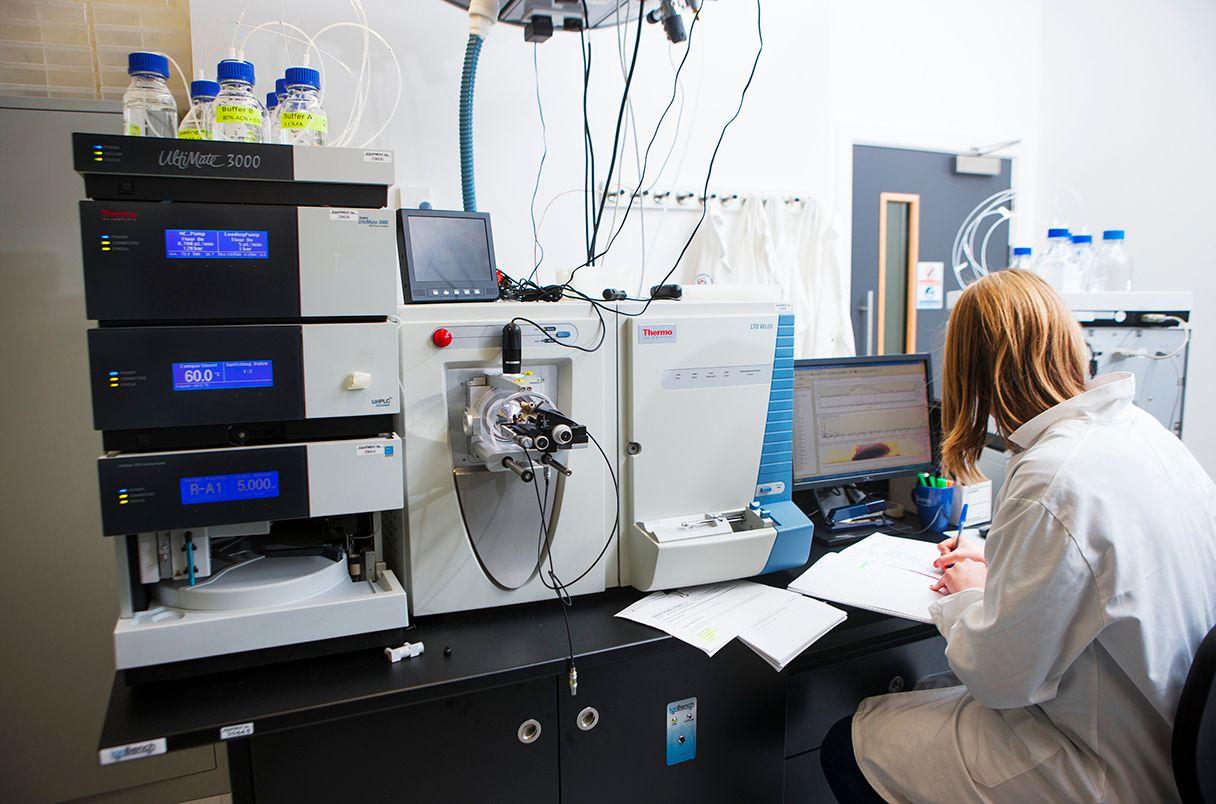AI-Powered Protein Engineering: EVOLVEpro Revolutionizes Protein Design for Medical and Environmental Applications
3 Sources
3 Sources
[1]
AI protein engineer capable of making proteins 'better, faster, stronger'
Nature is pretty good at designing proteins. Scientists are even better. But artificial intelligence holds the promise of improving proteins many times over. Medical applications for such "designer proteins" range from creating more precise antibodies for treating autoimmune conditions or cancers to more effective vaccines against viruses. Applications may extend beyond medicine to, for example, growing better crops that could be more nutritious or absorb more carbon dioxide from the atmosphere. Investigators from Mass General Brigham and Beth Israel Deaconess Medical Center (BIDMC) have developed an artificial intelligence (AI) tool known as EVOLVEpro that may represent a leap forward in protein engineering. In a paper published in Science, the research team demonstrates the tool's ability to make proteins more stable, precise, and efficient by applying the model to engineer six proteins with different applications. "The power of a tool like this is that we're not restricted by evolution. Using AI, we can choose to optimize a protein to be better in whatever way is needed," said co-senior author Omar Abudayyeh, PhD, an investigator at the Gene and Cell Therapy Institute at Mass General Brigham and Engineering in Medicine Division in the Department of Medicine at Brigham and Women's Hospital. Abudayyeh also has a secondary appointment in the Center for Virology and Vaccine Research at BIDMC and is an assistant professor at Harvard Medical School. "We can make a protein that's better, faster, stronger. We can design it to be more efficient at binding to a target to improve a therapy or improve its function. If we can measure it, we can improve upon it." The concept of protein engineering is not new, but the emergence of AI and large language models is beginning to revolutionize the field. Protein language models (PLMs) can learn the "grammar" of proteins, reading protein sequences from across large genomic databases and offering suggestions that can improve proteins in ways that a scientist specifies. Much like new LLMs, EVOLVEpro acts as a layer on top of previous models, which can reason and provide more thought before responding. "Protein modeling has advanced in recent years, and we wondered if we could now use large language models to essentially predict better protein sequences," said co-senior author Jonathan S. Gootenberg, PhD, of the Center for Virology and Vaccine Research at BIDMC, member of the Gene and Cell Therapy Institute at Mass General Brigham, and member of the faculty at Harvard Medical School. "Our results consistently show how well this tool can work. We picked two clinically relevant antibodies -- either already in use or close to human use -- and found that with EVOLVEpro, we could engineer an antibody that could bind better and had better expression. Usually, you can do well on one of those outcomes, but here we saw improvements to both." Studies like this one show the promise of advances in gene and cell therapy technologies for transforming medicine. The Mass General Brigham Gene and Cell Therapy Institute (GCTI) was established in 2022 to fuel the discovery and development of targeted, transformative treatments that have the potential to cure diseases or halt their progression. The Institute unites more than 500 researchers and clinicians dedicated to advancing gene and cell therapy for first-in-human clinical trials, and ultimately, life-saving treatments for patients. The research team for the Science paper, led by first authors Kaiyi Jiang and Zhaoqing Yan, of the Gene and Cell Therapy Institute at Mass General Brigham, and Matteo Di Bernardo at the Massachusetts Institute of Technology, used EVOLVEpro to engineer six proteins. The researchers found that the two monoclonal antibodies EVOLVEpro engineered were up to 30-fold better at sticking to their target. A miniature CRISPR nuclease was five times more effective at making genetic changes. A protein used for n gene editing, called a prime editor, was twice as good at inserting sequences into different parts of the genome. A protein called Bxb1 integrase was four times more efficient at inserting DNA into cells for programmable gene integration applications, and a protein for RNA production, a T7 RNA polymerase, was 100 times better at making accurate copies of RNA, which is important for manufacturing mRNA for mRNA therapies or vaccines. "We anticipate that this is just the beginning for EVOLVEpro, which will continue to improve with time and could be used for a wide variety of protein engineering applications," said Jiang. "This technology marks the beginning of a new era where we can design proteins not just to match nature's designs, but to solve challenges nature never had to face -- from creating more precise medicines to developing proteins that could help address global challenges like climate change and food security."
[2]
AI tool can engineer 'better, faster, stronger' proteins
Nature is adept at designing proteins. Scientists are even better. But artificial intelligence holds the promise of improving proteins many times over. Medical applications for such "designer proteins" range from creating more precise antibodies for treating autoimmune conditions or cancers to more effective vaccines against viruses. Applications may extend beyond medicine to -- for example -- growing better crops that could be more nutritious or absorb more carbon dioxide from the atmosphere. Investigators from Mass General Brigham and Beth Israel Deaconess Medical Center (BIDMC) have developed an artificial intelligence (AI) tool known as EVOLVEpro that may represent a leap forward in protein engineering. In a paper published in Science, the research team demonstrates the tool's ability to make proteins more stable, precise, and efficient by applying the model to engineer six proteins with different applications. "The power of a tool like this is that we're not restricted by evolution. Using AI, we can choose to optimize a protein to be better in whatever way is needed," said co-senior author Omar Abudayyeh, Ph.D., an investigator at the Gene and Cell Therapy Institute at Mass General Brigham and Engineering in Medicine Division in the Department of Medicine at Brigham and Women's Hospital. "We can make a protein that's better, faster, stronger. We can design it to be more efficient at binding to a target to improve a therapy or improve its function. If we can measure it, we can improve upon it." The concept of protein engineering is not new, but the emergence of AI and large language models is beginning to revolutionize the field. Protein language models (PLMs) can learn the "grammar" of proteins, reading protein sequences from across large genomic databases and offering suggestions that can improve proteins in ways that a scientist specifies. Much like new LLMs, EVOLVEpro acts as a layer on top of previous models, which can reason and provide more thought before responding. "Protein modeling has advanced in recent years, and we wondered if we could now use large language models to essentially predict better protein sequences," said co-senior author Jonathan S. Gootenberg, Ph.D., of the Center for Virology and Vaccine Research at BIDMC, member of the Gene and Cell Therapy Institute at Mass General Brigham, and member of the faculty at Harvard Medical School. "Our results consistently show how well this tool can work. We picked two clinically relevant antibodies -- either already in use or close to human use -- and found that with EVOLVEpro, we could engineer an antibody that could bind better and had better expression. Usually, you can do well on one of those outcomes, but here we saw improvements to both." Studies like this one show the promise of advances in gene and cell therapy technologies for transforming medicine. The Mass General Brigham Gene and Cell Therapy Institute (GCTI) was established in 2022 to fuel the discovery and development of targeted, transformative treatments that have the potential to cure diseases or halt their progression. The Institute unites more than 500 researchers and clinicians dedicated to advancing gene and cell therapy for first-in-human clinical trials, and ultimately, life-saving treatments for patients. The research team for the Science paper, led by first authors Kaiyi Jiang and Zhaoqing Yan, of the Gene and Cell Therapy Institute at Mass General Brigham, and Matteo Di Bernardo at the Massachusetts Institute of Technology, used EVOLVEpro to engineer six proteins. The researchers found that the two monoclonal antibodies EVOLVEpro engineered were up to 30-fold better at sticking to their target. A miniature CRISPR nuclease was five times more effective at making genetic changes. A protein used for n gene editing, called a prime editor, was twice as good at inserting sequences into different parts of the genome. A protein called Bxb1 integrase was four times more efficient at inserting DNA into cells for programmable gene integration applications, and a protein for RNA production, a T7 RNA polymerase, was 100 times better at making accurate copies of RNA, which is important for manufacturing mRNA for mRNA therapies or vaccines. "We anticipate that this is just the beginning for EVOLVEpro, which will continue to improve with time and could be used for a wide variety of protein engineering applications," said Jiang. "This technology marks the beginning of a new era where we can design proteins not just to match nature's designs, but to solve challenges nature never had to face -- from creating more precise medicines to developing proteins that could help address global challenges like climate change and food security."
[3]
New method uses AI to design artificial proteins
Protein design aims to create customized antibodies for therapies, biosensors for diagnostics, or enzymes for chemical reactions. An international research team has now developed a method for designing large new proteins better than before and producing them with the desired properties in the laboratory. Their approach involves a new way of using the capabilities of the AI-based software Alphafold2, for which the Nobel Prize in Chemistry was awarded in 2024. Whether as building blocks, transport systems, enzymes, or antibodies, proteins play a vital role in our bodies. Researchers are, therefore, trying to recreate them or to design so-called de novo proteins that do not occur in nature. Such artificial proteins are designed to bind to certain viruses or transport drugs, for example. Scientists are increasingly using machine learning to design them. Recently, advances in this field were honored with the Nobel Prize in Chemistry: This year's Nobel Prize went to David Baker, a pioneer of de novo protein design, and to the developers of the software Alphafold2 Demis Hassabis and John Jumper. This software makes it possible to predict protein structures on the computer with high accuracy. An international team led by Hendrik Dietz, Professor of Biomolecular Nanotechnology at the Technical University of Munich (TUM), and Sergey Ovchinnikov, Professor of Biology at MIT, has now developed a method that uses Alphafold2's accurate structure prediction together with a so-called gradient descent approach for efficient protein design. Their study is published in the journal Science. Gradient descent is a common method for model optimization. In a step-by-step process, it can be used to identify deviations from the desired target function and adjust the parameters until the optimal result is achieved. In protein design, gradient descent can be used to compare the structure of new proteins predicted by AlphaFold2 with the desired protein structure. This allows scientists to further optimize their newly designed amino acid chain and the resulting structure. The latter largely determines the stability and function of the protein and depends on subtle energetic interactions. Virtual superposition of the building blocks The new method makes it possible to design large new proteins better than before and to tailor them to the desired properties, for example, to bind precisely to other proteins. Their design process differs from previous approaches in several ways. "We have designed the process for new proteins so that we initially ignore the limits of what is physically possible. Usually, only one of the 20 possible building blocks is assumed at each point of the amino acid chain. Instead, we use a variant in which all possibilities are virtually superimposed," says Christopher Frank, doctoral candidate at the Chair of Biomolecular Nanotechnology and first author of the study. This virtual superposition cannot be directly translated into an actually producible protein. But it allows the protein to be iteratively optimized. "We improve the arrangement of the amino acids in several iterations until the new protein is very close to the desired structure," says Frank. This optimized structure is then used to determine the amino acid sequence that can actually be assembled into a protein in the laboratory. The crucial test: How do the predictions hold up in real life? The ultimate test for all newly designed proteins: does the actual structure correspond to the predicted construct and the desired function? Using the new method, the team designed more than 100 proteins virtually, produced them in the laboratory and tested them experimentally. "We were able to show that the structures that we designed are very close to the structures that are actually produced," says Frank. Using their new method, they were able to produce proteins consisting of up to 1,000 amino acids. "This brings us closer to the size of antibodies, and -- just as with antibodies -- we can then integrate several desired functions into such a protein," explains Dietz. "These could, for example, be motifs for recognizing and suppressing pathogens."
Share
Share
Copy Link
Researchers develop EVOLVEpro, an AI tool that significantly enhances protein engineering capabilities, promising advancements in medicine, agriculture, and environmental solutions.

AI Revolutionizes Protein Engineering with EVOLVEpro
In a groundbreaking development, researchers from Mass General Brigham and Beth Israel Deaconess Medical Center (BIDMC) have introduced EVOLVEpro, an artificial intelligence tool that marks a significant leap forward in protein engineering. Published in Science, this innovation promises to transform various fields, from medicine to agriculture and environmental science
1
.Surpassing Nature's Limitations
EVOLVEpro's power lies in its ability to optimize proteins beyond evolutionary constraints. Dr. Omar Abudayyeh, a co-senior author of the study, explains, "Using AI, we can choose to optimize a protein to be better in whatever way is needed. We can make a protein that's better, faster, stronger"
1
. This capability opens up possibilities for creating more precise antibodies, effective vaccines, and even improving crop nutrition and carbon dioxide absorption.Advanced AI Methodology
The tool utilizes large language models to learn the "grammar" of proteins, analyzing sequences from extensive genomic databases. EVOLVEpro builds upon previous models, adding a layer of reasoning that enhances its decision-making process
2
.Impressive Results Across Multiple Proteins
The research team, led by Kaiyi Jiang, Zhaoqing Yan, and Matteo Di Bernardo, demonstrated EVOLVEpro's effectiveness by engineering six different proteins:
- Monoclonal antibodies: Up to 30-fold improvement in target binding
- Miniature CRISPR nuclease: 5 times more effective at genetic modifications
- Prime editor: Doubled efficiency in genome sequence insertion
- Bxb1 integrase: 4 times more efficient in DNA insertion
- T7 RNA polymerase: 100 times better at accurate RNA replication
1
Broader Implications and Future Prospects
The success of EVOLVEpro signals the beginning of a new era in protein design. Jiang anticipates that this technology will continue to improve and find applications in addressing global challenges such as climate change and food security
2
.Related Stories
Complementary Advancements in AI-Driven Protein Design
Parallel to EVOLVEpro, another international team led by Hendrik Dietz and Sergey Ovchinnikov has developed a method using AlphaFold2 and gradient descent for efficient protein design. This approach allows for the design of large proteins up to 1,000 amino acids in size, approaching the complexity of antibodies
3
.Validation Through Experimental Testing
Both EVOLVEpro and the AlphaFold2-based method have undergone rigorous experimental testing. The proteins designed using these AI tools have been successfully produced in laboratories, with structures closely matching the predicted designs. This validation is crucial for the practical application of AI-designed proteins in real-world scenarios
3
.As these AI-driven protein engineering tools continue to evolve, they promise to accelerate advancements in medicine, biotechnology, and environmental science, potentially leading to more targeted therapies, improved vaccines, and innovative solutions to global challenges.
References
Summarized by
Navi
[3]
Related Stories
AI Revolutionizes Protein Sequencing: InstaNovo Models Enhance Accuracy and Discovery
31 Mar 2025•Science and Research

Google DeepMind Unveils AlphaProteo: Revolutionizing Protein Design with AI
06 Sept 2024

AI Breakthrough: Scientists Design Functional Antibodies from Scratch Using Machine Learning
05 Nov 2025•Science and Research








